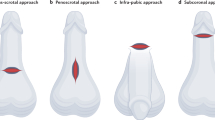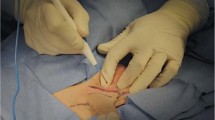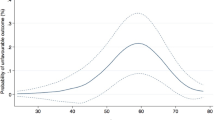Abstract
Testicular prosthesis implantation is a valuable solution for the physical, cosmetic, and psychological challenges associated with testicular loss which may affect males of any age. We evaluated the safety and reliability of the new Rigicon Testi10TM testicular prosthesis in adults and adolescents by performing an IRB-approved retrospective study of data drawn from Patient Information Forms (PIFs). A total of 427 patients (382 adults and 45 adolescents) had at least one testicular prosthesis implanted. Only one adult patient required revision surgery due to rupture of the Rigicon Testi10 TM saline-filled prosthesis. A 40-year-old patient was found to have a leaking prosthesis approximately one week postoperatively, which was suspected to be due to inadvertently punctured by the surgeon during the sterile saline filling process. There were no post-implantation revisions required for adolescent patients. According to our results, Kaplan–Meier calculation of survival from removal or revision was 99.8% for all patients at 54 months (99.7% for adults and 100% for adolescents). The complication rates among patients in this study are lower than those reported in previous published studies. Our study underscores the generally safe nature of testicular prosthesis implantation, as well as the very rare incidence of revision surgery for this new device.
This is a preview of subscription content, access via your institution
Access options
Subscribe to this journal
Receive 8 print issues and online access
$259.00 per year
only $32.38 per issue
Buy this article
- Purchase on Springer Link
- Instant access to full article PDF
Prices may be subject to local taxes which are calculated during checkout





Similar content being viewed by others
Data availability
The data generated during this study can be found within the published article or can be made available from the corresponding author on reasonable request.
References
Favorito LA, Klojda CA, Sampaio FJ. Congenital absence of the testis in human fetuses and in cryptorchid patients. Int J Urol. 2004;11:1110–3.
Echeverría Sepúlveda MP, Yankovic Barceló F, López Egaña PJ. The undescended testis in children and adolescents part 2: evaluation and therapeutic approach. Pediatr Surg Int. 2022;38:789–99.
Pesce C, Reale A, Sanguineti G. The pathology of testicular atrophy. Pathol Immunopathol Res. 1986;5:500–11.
Dax V, Ftanou M, Tran B, Lewin J, Wallace R, Seidler Z, et al. The impact of testicular cancer and its treatment on masculinity: A systematic review. Psychooncology. 2022;31:1459–73. https://doi.org/10.1002/pon.5994.
Hampl D, Koifman L, de Almeida R, Ginsberg M, Sampaio FJB, Favorito LA. Testicular torsion: a modified surgical technique for immediate intravaginal testicular prosthesis implant. Int Braz J Urol. 2021;47:1219–27.
Marshall S. Potential problems with testicular prostheses. Urology. 1986;28:388–90.
Niedzielski J, Nowak M, Kucharski P, Marchlewska K, Słowikowska-Hilczer J. Testicular, Epididymal and Vasal Anomalies in Pediatric Patients with Cryptorchid Testes and Testes with Communicating Hydrocele. J Clin Med. 2022;11:3015 https://doi.org/10.3390/jcm11113015.
Bodiwala D, Summerton DJ, Terry TR. Testicular prostheses: development and modern usage. Ann R Coll Surg Engl. 2007;89:349–53.
Money J, Sollod R. Body image, plastic surgery (prosthetic testes) and Kallmann’s syndrome. Br J Med Psychol. 1978;51:91–4.
Peycelon M, Rossignol G, Muller CO, Carricaburu E, Philippe-Chomette P, Paye-Jaouen A, et al. Testicular prostheses in children: Is earlier better? J Pediatr Urol. 2016;12:237.e1–6. https://doi.org/10.1016/j.jpurol.2016.04.022.
Bush NC, Bagrodia A. Initial results for combined orchiectomy and prosthesis exchange for unsalvageable testicular torsion in adolescents: description of intravaginal prosthesis placement at orchiectomy. J Urol. 2012;188:1424–8.
Rose M, Aberg M, Bohn J. Testicular prosthetic implants in boys and teenagers with primary or secondary anorchism. Scand J Plast Reconstr Surg Hand Surg. 2008;42:101–4.
Turek PJ, Master VA. Safety and effectiveness of a new saline filled testicular prosthesis. J Urol. 2004;172:1427–30.
Tsvetkov D, Tsvetkova P. Congenital anorchism – the diagnostic and treatment problems. Akush Ginekol. 1990;29:45–51.
Elder JS, Keating MA, Duckett JW. Infant testicular prostheses. J Urol. 1989;141:1413–5.
Hayon S, Michael J, Coward RM. The modern testicular prosthesis: patient selection and counseling, surgical technique, and outcomes. Asian J Androl. 2020;22:64–9.
Kogan S. The clinical utility of testicular prosthesis placement in children with genital and testicular disorders. Transl Androl Urol. 2014;3:391–7.
Mohammed A, Yassin M, Hendry D, Walker G. Contemporary practice of testicular prosthesis insertion. Arab J Urol. 2015;13:282–6. https://doi.org/10.1016/j.aju.2015.09.001.
Girsdansky J, Newman HF. Use of a vitallium testicular implant. Am J Surg. 1941;53:514.
Rea CE. An evaluation of therapy for the undescended testis. J Tn State Med Assoc. 1961;54:75–80.
Hazzard CT. The development of a new testicular prosthesis. J Urol. 1953;70:959–60.
Baumrucker GO. Testicular prosthesis for an intracapsular orchiectomy. J Urol. 1957;77:756–8.
Prentiss RJ, Boatwright DC, Pennington RD, Hohn WF, Schwartz MH. Testicular prosthesis: materials, methods and results. J Urol. 1963;90:208–10.
Lattimer JK, Vakili BF, Smith AM, Morishima A. A natural-feeling testicular prosthesis. J Urol. 1973;110:81–3. https://doi.org/10.1016/s0022-5347(17)60122-8.
Henderson J, Culkin D, Mata J, Wilson M, Venable D. Analysis of immunological alterations associated with testicular prostheses. J Urol. 1995;154:1748–51.
Robinson OG Jr, Bradley EL, Wilson DS. Analysis of explanted silicone implants: a report of 300 patients. Ann Plast Surg. 1995;34:1–6. https://doi.org/10.1097/00000637-199501000-00001.
Yossepowitch O, Aviv D, Wainchwaig L, Baniel J. Testicular prostheses for testis cancer survivors: patient perspectives and predictors of long-term satisfaction. J Urol. 2011;186:2249–52. https://doi.org/10.1016/j.juro.2011.07.075.
Adshead J, Khoubehi B, Wood J, Rustin G. Testicular implants and patient satisfaction: a questionnaire-based study of men after orchidectomy for testicular cancer. BJU Int. 2001;88:559–62. https://doi.org/10.1046/j.1464-4096.2001.02392.x.
Pidutti R, Morales A. Silicone gel-filled testicular prosthesis and systemic disease. Urology. 1993;42:155–7.
Genest H, Guidoin R, Plante R, Gosselin C, Blais P, Robert G, et al. Analyse d’implants testiculaires en silicone après exérèse [Analysis of silicone testicular implants after explantation]. J Urol. 1982;88:337–43.
Osemlak P, Jędrzejewski G, Cielecki C, Kalińska-Lipert A, Wieczorek A, Nachulewicz P. The use of testicular prostheses in boys. Medicine. 2018;97:e13911 https://doi.org/10.1097/MD.0000000000013911.
Wilson SK, Haxhimolla H, Kua B, Testa G, Love C, Rossello M, et al. Survival From Revision Surgery for New Rigicon Infla10 Three-piece Inflatable Penile Prosthesis Is Comparable to Preceding Devices. Urology. 2023;180:257–61. https://doi.org/10.1016/j.urology.2023.06.031.
Carson CC, Mulcahy JJ, Govier FE. Efficacy, safety, and patient satisfaction outcomes of the AMS 700CX inflatable penile prosthesis: results of a long-term multicenter study. AMS 700CX Study Group. J Urol. 2000;164:376–80.
Wilson SK, Cleves MA, Delk JR 2nd. Comparison of mechanical reliability of original and enhanced Mentor Alpha I penile prosthesis. J Urol. 1999;162:715–8.
Wilson SK, Wen L, Rossello M, Maria P, Carrion R, Perito P, et al. Initial safety outcomes for the Rigicon Infla10® inflatable penile prosthesis. BJU Int. 2023;131:729–33. https://doi.org/10.1111/bju.15960.
Author information
Authors and Affiliations
Contributions
All authors have made substantial contributions to this work. All authors (BLA, DK, SKW, OK, RSP, CMV, ND, MSG) were involved in the acquisition, analysis, and interpretation of data for the work, with final statistical analyses performed by OK. SKW, BLA, OK & MSG all contributed to drafting the manuscript and revised it critically for important intellectual content including final approval of the version to be published. All authors agree to be accountable for all aspects of the work in ensuring that questions related to the accuracy or integrity of any part of the work are appropriately investigated and resolved.
Corresponding author
Ethics declarations
Competing interests
DK is a paid employee of Rigicon responsible for PIF data assemblage. SW is a consultant for Rigicon. All other authors have nothing to disclose related to this article.
Additional information
Publisher’s note Springer Nature remains neutral with regard to jurisdictional claims in published maps and institutional affiliations.
Rights and permissions
Springer Nature or its licensor (e.g. a society or other partner) holds exclusive rights to this article under a publishing agreement with the author(s) or other rightsholder(s); author self-archiving of the accepted manuscript version of this article is solely governed by the terms of such publishing agreement and applicable law.
About this article
Cite this article
Atwater, B.L., Kirkik, D., Wilson, S.K. et al. Short-term revision rate of Rigicon Testi10TM testicular prosthesis in adolescents and adults: a retrospective chart review. Int J Impot Res (2024). https://doi.org/10.1038/s41443-024-00893-8
Received:
Revised:
Accepted:
Published:
DOI: https://doi.org/10.1038/s41443-024-00893-8



